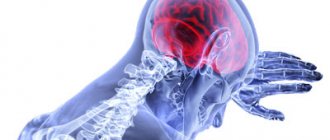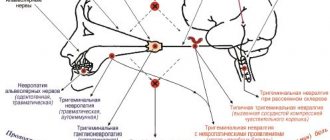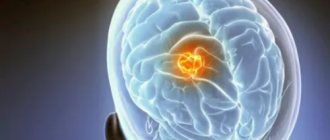The phenomenon of coma has been known since ancient times and is still not fully understood. The term is translated from Greek as “deep sleep.” In reality, a coma has very little in common with sleep; it is a dangerous near-death state.
The modern medical community views coma as a defensive reaction, which manifests itself in the loss of consciousness in response to critical disruptions in the functioning of the body. When a person remains unconscious for a long time, irreversible changes begin to occur in the body: reflex activity decreases, breathing becomes difficult, blood circulation is disrupted, and failures occur in almost all vital systems.
What causes coma: the main reasons
It is believed that a person can fall into a coma due to impaired blood circulation in the cerebral cortex. Another most common cause is toxic damage to cells of the central nervous system. Various diseases or injuries can provoke the occurrence of pathologies:
- strokes;
- traumatic brain injuries;
- decompensated diabetes mellitus;
- inflammatory diseases: meningitis, encephalitis;
- poisoning resulting in pathologies in the kidneys or liver;
- a series of consecutive epileptic seizures;
- hypoxia as a result of suffocation, drowning, cardiac arrest.
In medicine, there is such a thing as a medically induced coma. In this case, the patient is deliberately rendered unconscious using special drugs. This method is used for complex neurosurgical procedures, as well as to stop epileptic seizures in especially severe cases.
Funeral arrangements
Comatose state (coma)
A coma is a life-threatening condition characterized by loss of consciousness, a sharp weakening or lack of response to external stimuli, extinction of reflexes until they disappear completely, impaired depth and frequency of breathing, changes in vascular tone, increased or slowed pulse, and impaired temperature regulation.
The main causes of coma are:
1. Primary brain injury: Traumatic brain injury, cerebrovascular disease, central nervous system infections, tumors, hydrocephalus, seizures and post-seizure conditions.
2. Somatogenic disorders: metabolic disorders (hypoglycemia, diabetic ketoacidosis, hyperglycemic non-ketotic state, uremia, liver failure, hyponatremia, hypothyroidism, hyper- or hypocalcemia, panhypopituitarism), hypoxia (pulmonary diseases, anemia, shock, arrhythmia, myocardial infarction, pulmonary embolism arteries), acute hypertensive encephalopathy, nutritional disorders (Wernicke encephalopathy).
3. External influences: poisoning (with alcohols, ethylene glycol, carbon monoxide, opiates, barbiturates, heavy metals, etc.), hyper- and hypothermia, electrical trauma.
THE INVESTIGATION PROGRAM for a patient in a comatose state includes:
• Examination by specialist doctors upon admission and during follow-up in the intensive care unit and resuscitation department. • Standard studies: CBC, TAM, electrolytes, urea, creatinine, glucose, blood calcium, enzymes, serum osmolality; ECG and chest x-ray. • Screening for toxic substances: determination of opiates, cocaine, ethanol, barbiturates, sedatives, antidepressants in blood, urine and gastric contents. • Special studies: R-graphy of the skull, EEG, lumbar puncture if encephalitis or meningitis is suspected in the absence of signs of increased ICP and cerebral edema, CT or MRI of the brain.
MAIN ETHIO-PATHOGENETIC VARIANTS OF COMATOUS CONDITIONS AND THEIR SIGNS. Diabetic ketoacidemic coma
• Precomatose period: weakness, dry mouth, cephalgia, polyuria, polydipsia. • Gradual depression of consciousness. • Clinically: The skin is dry, hot, turgor is reduced, the eyeballs are soft, Kussmaul's breath, the smell of acetone. Tachycardia, hypotension. Hypothermia. Hyporeflexia. Abdominal muscle tension. • Laboratory data: hyperglycemia 20-50 mmol/l, ketonemia 0.8-5.0 mmol/l (normal <0.15); the appearance of ketones in the urine, hyponatremia, hypokalemia, hypochloremia, hyperosmolality (330-350 mOsm/l), acidosis (pH up to 7.2).
Diabetic hyperosmolar coma
• More often develops in non-insulin-dependent diabetes (the insulin produced is sufficient to inhibit lipolysis and prevent ketoacidosis, but not enough to eliminate hyperglycemia). • Precomatose period: weakness, dry mouth, cephalgia, polyuria, polydipsia. • Gradual development. • Clinically: Signs of dehydration: severe dry skin, reduced turgor, soft eyeballs, shallow breathing. Tachycardia, hypotension up to a collaptoid state. • Laboratory data: hyperglycemia up to 60 and above mmol/l, blood hyperosmolality above 350 mOsm/l, absence of ketoacidosis.
Hypoglycemic coma
• Precursors of coma: weakness, pallor, sweating, body tremors, cephalgia, feeling of hunger. • Development of coma is rapid. • Clinically: the skin is moist, the turgor of the skin and eyeballs is preserved. Transient dilation of the pupils is possible. Breathing – hyperventilation. • Laboratory data: hypoglycemia 1.0-2.2 mmol/l
Hepatic coma
• Precomatose state: liver signs: jaundice, telangiectasia, erythema of the palms, dry skin and mucous membranes, ascites, “head of the jellyfish”; excitement, euphoria, mydriasis, lethargy of photoreactions, bradycardia, when coma approaches - hypotension, tremor, hyperkinesis, stupor. • Development of coma is gradual. • Clinically: hyperreflexia with protective and bilateral pathological reflexes, with deepening coma - hyporeflexia; hypotension, tachycardia, mydriasis. Kussmaul breath, liver smell of exhaled air (smell of rotten fruit, mold). Oliguria. • Laboratory data: bilirubin >35 µmol/l, ammonia >150 µmol/l
Hypochloremic coma
• Precomatose state: diseases accompanied by repeated vomiting, diarrhea, forced diuresis. • Gradual development of coma. • Clinically: dry skin and mucous membranes, decreased skin turgor, hypotension, tachycardia, convulsive syndrome. • Laboratory data: hypochloremia <90 mmol/l, hyponatremia, alkalosis, azotemia.
Uremic coma
• Precomatose state: inadequacy, delirium in a patient with renal failure • Development of coma is gradual. • Clinically: dry skin, scratching. Tachycardia, hypertension. Constriction of the pupils, myoclonus and generalized seizures. Cheyne-Stokes, Kussmaul breath, ammonia breath. • Laboratory findings: hyperazotemia, hypernatremia, hyperkalemia, acidosis, hyperosmolality.
Alcohol coma
• Precursors of coma: signs of intoxication, agitation, sometimes convulsions, vomiting. • Development of coma is gradual. • Clinical picture: hyperemia of the face and conjunctiva, injection of scleral vessels, pupils are constricted (with increasing respiratory distress they can dilate), tense pulse, tachycardia. Breathing is shallow. Familiar smell from the mouth. As the coma deepens, skin cyanosis, cold sweat, hypothermia, decreased blood pressure. Usually – involuntary urination and defecation. Muscle hypotonia, areflexia. • Laboratory findings: blood alcohol level more than 3 g/l, acidosis, mild to moderate leukocytosis.
Drug coma
• Precomatose period: taking unusually large doses of drugs (morphine, omnopon, heroin, codeine, promedol, etc.). Drowsiness, decreased pain sensitivity, vomiting. • Development of coma is gradual. • Clinical picture: skin cyanosis, cold sweat, hypothermia, severe miosis (reaction to light can often be detected only with a magnifying glass). Breathing is shallow, intermittent, and may be of the Cheyne-Stokes type. Hypotension, possible collapse, pulmonary edema. • Laboratory: narcotic substances and their metabolites in the blood and urine.
Pseudocomatose states
• Psychogenic unresponsiveness: wakefulness in the absence of reactions to examination, addressed speech. No focal symptoms are detected; when trying to open the eyes, there is active resistance, active avoidance of one’s own hand when the doctor tries to throw it on the patient’s face. EEG is normal. • Isolation syndrome (defferentation, closure) with damage to the brain stem at the level of the pons: consciousness and visual contact are preserved, tetraparesis and pseudobulbar palsy. Normal EEG. • Non-convulsive status epilepticus: subtle signs of a convulsive state, anamnestic information. Constant epiactivity on the EEG.
Depth of coma
There is a widespread belief that a person always falls into a coma suddenly. However, this is not the case. In some cases, it can even develop over several days.
Comatose states are divided according to the degree of their depth. It is customary to distinguish several stages:
- Prekoma. It is characterized by the patient experiencing stupor, slowness of reaction, or, conversely, increased excitability. Basic reflexes are preserved, but mental activity is deformed.
- Superficial coma. The person is in a state of stupor or falls asleep. A complete blackout of consciousness does not occur; some simple movements are preserved.
- Deep coma. The patient spends all the time unconscious, muscle movement occurs reflexively. Reactions to external stimuli are weakened.
- Atonic coma. Reflexes disappear, all systems stop functioning independently, and the patient is connected to life support machines.
The last stage of a coma can most likely lead to death. However, medical practice knows cases when even the most severe patients were able to return to consciousness with partial or almost complete restoration of cognitive functions.
Signs of a coma
Coma I degree
It is called subcortical because at this stage the activity of the cerebral cortex is inhibited and the deeper parts of the brain, called subcortical formations, are disinhibited. It is characterized by the following manifestations:
- the feeling that the patient is in a dream;
- complete disorientation of the patient in place, time, personality (it is impossible to rouse the patient);
- lack of answers to questions asked. Possible inarticulate mooing, making various sounds out of connection with what is happening outside;
- the absence of a normal reaction to a painful stimulus (that is, the reaction is weak and very slow, for example, when a needle pricks the patient’s arm, the patient does not withdraw it immediately, but only weakly bends or straightens it some time after the painful stimulus is applied);
- spontaneous active movements are practically absent. Sometimes sucking, chewing, and swallowing movements may occur as a manifestation of brain reflexes, which are normally suppressed by the cerebral cortex;
- increased muscle tone;
- deep reflexes (knee, Achilles and others) are increased, and superficial (corneal, plantar and others) are inhibited;
- pathological hand and foot symptoms are possible (Babinsky, Zhukovsky and others);
- the reaction of the pupils to light is preserved (constriction), strabismus and spontaneous movements of the eyeballs may be observed;
- lack of control over the activity of the pelvic organs;
- usually spontaneous breathing is preserved;
- on the part of cardiac activity, an increase in heart rate (tachycardia) is observed.
Coma II degree
At this stage, the activity of subcortical formations is inhibited. The disturbances extend down to the anterior parts of the brainstem. This stage is characterized by:
- the appearance of tonic convulsions or periodic shudders;
- lack of speech activity, verbal contact is impossible;
- a sharp weakening of the reaction to pain (slight movement of the limb when applying an injection);
- inhibition of all reflexes (both superficial and deep);
- constriction of the pupils and their weak reaction to light;
- increased body temperature;
- increased sweating;
- sharp fluctuations in blood pressure;
- severe tachycardia;
- breathing disorders (with pauses, with stops, noisy, with different depths of inspiration).
Coma III degree
Pathological processes reach the medulla oblongata. The risk to life increases and the prognosis for recovery worsens. The stage is characterized by the following clinical signs:
- defensive reactions in response to a painful stimulus are completely lost (the patient does not even move the limb in response to the injection);
- there are no superficial reflexes (in particular, corneal);
- there is a sharp decrease in muscle tone and tendon reflexes;
- pupils are dilated and do not react to light;
- breathing becomes shallow and arrhythmic, less productive. Additional muscles (muscles of the shoulder girdle) are involved in the act of breathing, which is not normally observed;
- blood pressure decreases;
- Periodic convulsions are possible.
Coma IV degree
At this stage, there are no signs of brain activity. This shows up:
- absence of all reflexes;
- the maximum possible dilation of the pupils;
- muscle atony;
- lack of spontaneous breathing (only artificial ventilation supports the body's supply of oxygen);
- blood pressure drops to zero without medication;
- drop in body temperature.
Reaching stage IV coma has a high risk of death, approaching 100%.
It should be noted that some symptoms of different stages of coma may differ depending on the cause of the coma. In addition, certain types of comatose states have additional signs, which in some cases are diagnostic.
The role of communication with a person in a coma
There is no consensus on the benefits of communicating with a person in a coma. However, scientists have reason to believe that, to some extent, the patients' subconscious retains the ability to perceive external signals.
The patients themselves, who were lucky enough to emerge from a comatose state, report that their sensations were close to falling asleep. None of the respondents could accurately describe what happened while they were unconscious.
Although the benefits of communicating with comatose patients have not been proven, family members and acquaintances often express a desire to maintain contact with their loved ones. In this case, the recommendations are as follows:
- Introduce yourself and share positive news. You should maintain a calm, measured tone and an average volume of your voice.
- It is better to conduct a conversation with a patient in a coma as if he were conscious and acting as a listener.
- Relatives can express their support by sitting next to, touching, or holding the patient’s hand. Sometimes relatives read books aloud.
- There is a theory about the beneficial effects of music. People who are unconscious are allowed to play their favorite songs in their headphones.
Diagnosis and treatment
The diagnosis of cerebral coma cannot be established through examination alone, although typical signs of coma may indicate its development. A thorough neurological examination is required, using special rating scales. An electroencephalogram and computed tomography are also necessary to diagnose cerebral coma.
Treatment depends on the cause of the coma, that is, if the cerebral coma is toxic, then the cause that caused it is eliminated and detoxification therapy is carried out. Tracheal intubation, dynamic assessment and maintenance of vital signs, and careful nursing all require admission to the intensive care unit.
How is rehabilitation after a coma?
Bringing a patient out of a coma is often not an easy task. However, doctors are making every effort to ensure that consciousness is restored and the person can return to a full life. For this purpose, various drug therapy regimens are used. In case of a favorable outcome, subsequent rehabilitation is carried out.
The main task at this stage is to create in the patient the mood for a complete recovery and return to his former life. Often, a comatose state and subsequent treatment becomes a difficult experience for a person, and he needs the help of specialists. You should seek support from specialized rehabilitation centers.
In Belarus, in 2004, a medical rehabilitation center was formed on the basis of the Republican Clinical Hospital in the village of Aksakovshchina, Minsk region. Anyone in need can get help here for free.
Prognosis and possible prevention
Predicting the situation while a patient is in a coma is based on the degree of brain damage and the causes of the disease. The more severe the patient’s condition, the more likely an unfavorable outcome is possible. The patient's chances of recovery are assessed according to the following measures:
- precoma, coma I - the prognosis is favorable, complete recovery is possible without residual effects;
- coma II and III - an unreliable position that can lead to both recovery and death of the patient,
- coma IV - in most cases leads to the death of the patient, the prognosis is extremely unfavorable.
Early prevention is focused on timely diagnosis of major disorders of the cardiovascular system, various tumor pathologies and other conditions that can lead to coma.
Prognosis for coma
The outcome of this condition depends on the degree of brain damage, as well as on the nature of the reasons that caused it. In practice, the chances of emerging from a coma are high for those patients who were in a mild coma. So, for example, in the case of precoma or first degree coma, the outcome of the disease will most often be favorable with the patient’s complete recovery. In the case of coma II and III degrees, a favorable outcome is already in doubt: the probability of recovering or not leaving the coma is the same. The most unfavorable prognosis is for stage IV coma, which in almost all cases ends in the death of the patient.
Among the main preventive actions of a comatose state are timely diagnosis, correct prescription of treatment, and, if correction of pathological conditions is necessary, its timely implementation.
Treatment of coma
Treatment of a comatose state should take place in two directions: on the one hand, maintaining the vital functions of the human body in order to prevent possible brain death; on the other hand, treatment is aimed at eliminating the underlying cause that contributed to the development of the coma.
The first route, aimed at maintaining vital functions, usually begins in the ambulance. First aid is carried out to all patients without exception, long before test results are received.
This involves performing procedures aimed at maintaining normal airway patency:
- correction of a sunken tongue;
- cleansing the oral and nasal cavities from vomit present in them;
- use of an oxygen mask (if required);
- use of a breathing tube (in the most severe cases).
In addition, it is necessary to establish normal blood circulation by administering antiarrhythmic drugs that will help normalize blood pressure. The patient may also undergo cardiac massage.
In intensive care, the patient can be connected to an artificial respiration apparatus, which is done in extremely severe comatose states. If there are convulsive characteristics, it will be necessary to introduce glucose into the blood and normalize body temperature. For this, the patient is covered with a warm blanket or placed around with heating pads. If the patient is suspected of being poisoned with narcotic or sleeping pills, the stomach is washed.
The second stage of treatment involves performing a thorough examination using highly qualified tactics, which will depend on the root cause that caused the coma. If the cause is a brain tumor or a resulting hematoma, then surgery should be immediate.
Diagnosis of coma
Diagnosis of a coma involves performing two tasks: determining the cause that caused this condition, and conducting direct diagnosis and differential diagnosis in order to exclude other coma-like conditions.
A survey conducted among the patient’s relatives or people who witnessed this case will help determine the causes of coma. When conducting such a survey, they clarify whether the patient previously had complaints from the cardiovascular or endocrine systems. Witnesses are questioned about whether there were blisters or other packaging with medications near the patient.
Of great importance in diagnosing coma is the ability to determine the rate of developing symptoms and the age of the patient. If a coma is diagnosed in a young person, it is often caused by drug poisoning or an overdose of sleeping pills. For older people, coma is typical in the presence of cardiovascular diseases, heart attack or stroke.
When examining the patient, it is possible to presumably establish the cause that contributes to the onset of the coma. The presence of coma is also determined by the following signs:
- heart rate;
- blood pressure level;
- presence or absence of respiratory movements;
- characteristic bruising;
- bad breath;
- Body temperature.










